Boracay
Boracay is a small island in the Philippines, 7 km long and 1 km wide, located in the Western Visayas approximately 315 kilometres (196 miles) south of Manila and 2 kilometres (1.2 mi) off the northwest tip of Panay Island. Boracay has a population of 32,267 as of February 2016.
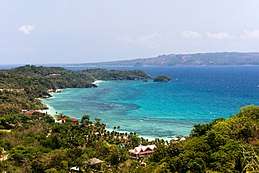 White Beach, Boracay | |
.svg.png) Boracay Location of Boracay .svg.png) Boracay Boracay (Philippines) | |
| Geography | |
|---|---|
| Coordinates | 11°58′8″N 121°55′26″E |
| Archipelago | Visayas |
| Adjacent bodies of water | |
| Area | 10.32 km2 (3.98 sq mi) |
| Highest elevation | 100 m (300 ft) |
| Highest point | Mount Luho |
| Administration | |
| Region | Western Visayas |
| Province | Aklan |
| Municipality | Malay |
| Barangays |
|
| Demographics | |
| Population | 28,369 [1] (2010) |
| Pop. density | 2,749/km2 (7,120/sq mi) |
| Ethnic groups | |
The island comprises the barangays of Manoc-Manoc, Balabag, and Yapak in the municipality of Malay, in Aklan Province. The island is administered by the Boracay Inter-agency Task Force. Apart from its white sand beaches, Boracay is also famous for being one of the world's top destinations for relaxation.[2][3] As of 2013, it was emerging among the top destinations for tranquility and nightlife.[4]
Boracay was awarded as the 2012 Best Island in the World by the international travel magazine Travel + Leisure.[5][6] In 2014, the resort island was at the top of the "Best Islands in the World" list published by the international magazine Condé Nast Traveler.[7] In 2016, Boracay headed the magazine's list of "Top 10 destinations to watch".[8]
In April 2018, the Philippine Government decreed a 6-month closure of the island for tourists to undertake major renovation works, especially of the sewage system, which had become obsolete and insufficient.[9] It re-opened in October 2018, with a set of new rules meant to address a variety of issues.[10][11] The island closed again in 2020 in response to the global COVID-19 pandemic.[12]
Etymology
The name Boracay is attributed to different origins. One story says that it is derived from the local word "borac" which means white cotton with characteristics close to the color and texture of Boracay's white sugary and powdery sand.[13] Ati tradition states that the name of the island came from the Inati words "bora", meaning bubbles, and "bocay", meaning white.[14] Yet another version dating back to the Spanish era says the name is derived from "sagay", the word for a shell, and "boray", the word for seed.[13]
History
Pre-colonial period
Before the Spanish colonization of the Philippines in the 16th century, Boracay was populated by Ati people. It was known to the Iberian conquerors as Buracay. At the time of contact with the Europeans, Buracay had a population of one hundred people, who cultivated rice on the island and augmented their income by raising goats.[15]
Contemporary period
As an agricultural island
Boracay is part of Aklan, which became an independent province on April 25, 1956.[16][17][18]
Boracay was largely an agricultural community like other parts of the country.[19] Around 1900 A.D., Sofía Gonzáles Tirol and her husband Lamberto Hontiveros Tirol (a town judge on the Panay mainland) took ownership of substantial properties on the island. They planted coconuts, fruit trees and greenery. Others followed the Tirols, and cultivation and development of the island gradually spread.[20] The production of copra and fishing were major industries in the island. However, due to over harvesting by fishers and the destruction of coral reef due to cyanide fishing, the fishing industry saw a decline. By the 1980s, the price of copra had declined, encouraging tourism as an alternative source of income for the island.[19]
Influx of tourism (1970s to 1997)
.jpg)
Tourism came to the island beginning sometime in the 1970s.[21][22] In 1970, the movies Nam's Angels (released in the U.S. as The Losers) and Too Late the Hero used filming locations on Boracay and Caticlan.[23] There was an influx of Western tourists after German writer Jens Peter called it "paradise on Earth" in his book about the Philippines in 1978.[24][25] In the 1980s, the island became popular as a budget destination for backpackers.[16] By the 1990s, Boracay's beaches were being acclaimed as the best in the world.[26] However, in 1997, the tourist arrival to the resort island dropped 60 percent due to the increase of coliform bacteria from poor sewage and septic system of the island.[27]
1997 to 2018
The conditions of Boracay in 1997 led to the installment of a potable water supply system, a sewage treatment plant and a solid waste disposal system in Boracay which was operated by the Philippine Tourism Authority (PTA). The environmental concerns persisted due to noncompliance of numerous business establishments.[27]
Then President Gloria Macapagal Arroyo declared Boracay a Special Tourism Zone in 2005 while in April 2006 she gave the PTA administrative control over the island while mandating the agency to coordinate with the provincial government of Aklan.[27]
In 2012, the Philippine Department of Tourism reported that Boracay had been named the world's second best beach after Providenciales in the Turks and Caicos Islands.[28]
2018 closure and rehabilitation
Due to worsening environmental conditions in Boracay, President Rodrigo Duterte in February 2018 said he planned to close the resort island, which he described as a "cesspool", on April 26, 2018, instructing Environment and Natural Resources Secretary Roy Cimatu to resolve the issue.[29] In a cabinet meeting, President Duterte approved the full closure of the island for six months, effective April 26, 2018 to rehabilitate and resolve the environmental issues surrounding Boracay.[30] On May 30, 2018, President Duterte declared that he planned to make the entire Boracay a land reform area and wanted to prioritize first the island's residents.[31][32]
In April 2018, the Philippine Army's 301st Infantry Brigade confirmed that 200 soldiers were deployed to Boracay to secure the island during its shutdown starting April 26.[33]
On October 26, 2018, Boracay was re-opened to the public with work on the island infrastructure still in progress.[34] In April 2019, numerous Chinese-owned businesses were opened in Boracay,[35] additionally, there are about 300 mainland Chinese citizens.[36] In April 2019, Labor Secretary Silvestre Bello said that the Department of Labor and Employment has no control over foreign businesses setting up shop on the island, but that it vows to ensure that no Chinese national could take jobs fit for Filipinos.[36][37]
2020 closure
The municipality of Malay, including Boracay island, was closed to tourism effective March 19, 2020 in response to the global COVID-19 pandemic. Workers and residents of Malay town are exempted from the entry ban but those coming from areas with confirmed COVID-19 cases are required to undergo a 14-day quarantine.[12]
Geography

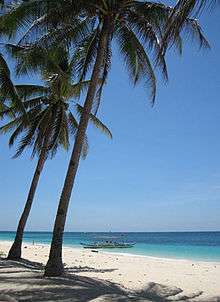
Boracay Island is located off the northwest corner of Panay Island, and belongs to the Western Visayas island-group, or Region VI, of the Philippines. The island is approximately seven kilometers long, dog-bone shaped with the narrowest spot being less than one kilometer wide, and has a total land area of 10.32 square kilometers.
South-facing Cagban Beach is located across a small strait from the jetty port at Caticlan on Panay island, and the Cagban jetty port serves as Boracay's main entry and exit point during most of the year. When wind and sea conditions dictate, east-facing Tambisaan Beach serves as an alternative entry and exit point.[38] Boracay's two primary tourism beaches, White Beach and Bulabog Beach, are located on opposite sides of the island's narrow central area. White Beach faces westward and Bulabog Beach faces eastward. The island also has several other beaches.
White Beach, the main tourism beach, is about four kilometers long and is lined with resorts, hotels, lodging houses, restaurants, and other tourism-related businesses. In the central portion, for about two kilometers, there is a footpath known as the Beachfront Path separating the beach itself from the establishments located along it. North and south of the Beachfront Path, beachfront establishments do literally front along the beach itself. Several roads and paths connect the Beachfront Path with Boracay's Main Road, a vehicular road which runs the length of the island. At the extreme northern end of White Beach, a footpath runs around the headland there and connects White Beach with Diniwid Beach.
Bulabog Beach, across the island from White Beach, is the second most popular tourism beach on the island and Boracay's main windsurfing and kiteboarding area.
Boracay is divided for land use and conservation purposes into 400 hectares of preserved forestland and 628.96 hectares of agricultural land.[39][40][41][42][43][44]
Climate
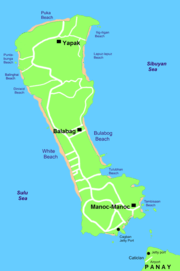
Weather in Boracay is generally divided into two seasonal weather patterns known locally as the Amihan and Habagat seasons. In the Visayan language, Amihan means a cool northeast wind, and Habagat means west or southwest wind; southwest monsoon.[45] The Amihan season is characterized by moderate temperatures, little or no rainfall, and a prevailing wind from the northeast. The Habagat season is characterized by hot and humid weather, frequent heavy rainfall, and a prevailing wind from the west.[46]
On Boracay, the main indicator of the switch between the Amihan and Habagat seasonal patterns is the switch in wind direction. In most years this transition is abrupt and occurs overnight. In some years there is a period of perhaps a week or two where the wind will switch between Amihan and Habagat patterns several times before settling into the pattern for the new season. As a rule of thumb, Boracay will be in the Amihan weather pattern from sometime in October to sometime in June and in the Habagat weather pattern for the remainder of the year.[47]
Temperatures in Malay municipality province generally ranged between 25-30°C in 2009–2019, with a low of 24°C in February 2014 and high of 31°C in October 2018, ranging more widely in 2019, with a low of 23°C in March and a high of 33°C in May.[48] During Tropical storm periods, temperatures can fall below 30°C. Tropical storms can impact Boracay at any time of year, but are most likely to be seen during the Habagat season.[49]
Environment
Fauna
At least three species of flying foxes has been recorded to inhabit Boracay namely the giant golden-crowned flying fox (Aceradon jubatus), the giant fruit bat (Pteropus vampyrus), and the small flying fox (Pteropus hypomelanus). Their population is concentrated on the northern side of the island in Barangay Yapak where the hunting of bats was made illegal through a local ordinance.[50]
According to the Coastal Ecosystem Conservation and Adaptive Management (CECAM), a study led by the Japan International Cooperation Agency conducted from 2010 to 2015 noted a 70.5 percent decrease of Boracay's coral cover from 1988 to 2011. The study attributed the worse drop in coral cover from 2008 to 2011 to the 38.4 percent increase of tourist arrivals combined with poorly monitored snorkeling activity in coral rich areas.[51][52] The Boracay Foundation Inc. (BFI) made efforts to remedy the situation by launching a "reefurbishment" program for the corals. In 2017, the BFI claimed the number of corals in Boracay increased from 15 to 20 percent since 2015 due to its project.[53]
Sanitation
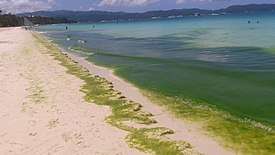
Boracay has been experiencing an increased coliform bacteria population since the 1990s which contributed to a 60 percent decline in tourist arrivals in 1997. Although a potable water supply system, a solid waste disposal system, as well as a sewage treatment plant which began operation in 2003 were installed to remedy the insufficient sewage and septic conditions in the island, environmental concerns regarding coliform bacteria persisted due to noncompliance of some business establishments in the island.[27]
In 2004, only 51 percent of hotels and restaurants in Boracay and 25 percent of all households were connected to the island's central sewage system. In 2005, Boracay was declared a "special tourism zone". In April 2006, Arroyo gave the PTA administrative control over Boracay, to be exercised in coordination with the provincial government. In 2009, Boracay Island Water Co. (BIWC), won a contract to improve the supply of potable water and install an efficient sewerage system.[27]
Boracay has experienced abnormally high algae growth since February 2015, due to sewage being dumped into the waters surrounding the islands.[27] In early 2018, 50 to 60 percent of all establishments in Boracay were compliant to the Clean Water Act of 2004 according to the Department of Environment and Natural Resources.[54]
Tourism
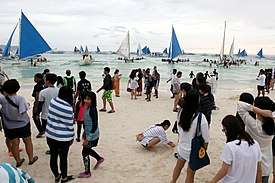
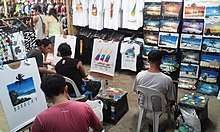
Partly because of its wind and weather patterns, tourism in Boracay is at its peak during the amihan season (which starts in September or October and ends sometime in May or June). During amihan, the prevailing wind blows from the east. Boracay's main tourism area, White Beach, is on the western side of the island and is sheltered from the wind. During the Amihan season, the water off White Beach is often glassy-smooth. On the eastern side of the island, hills on the northern and southern ends of the island channel the Amihan season wind from the east onshore, onto Bulabog Beach in the central part of the island's eastern side. This makes the reef-protected waters off that beach relatively safe[55] and ideal for scuba diving, windsurfing, and kiteboarding / kitesurfing.
In June 2011, it was reported that Megaworld Corporation, a real estate development group led by Andrew Tan had earmarked PHP20 billion to develop tourism estates in Boracay and Cavite. The planned Boracay project, Boracay Newcoast, involves four hotels with 1,500 rooms, a plaza and an entertainment center.[56]
Other resorts in Borocay include Discovery Shores, a luxury five-star resort managed by a Filipino hospitality group called The Discovery Leisure Company Inc. and owned by Discovery World Corp.[57][58] The building, with 88 suites, a spa, and four restaurants and bars,[59][60] stands at Station One on the White Beach, and has been described as "more Miami chic than hidden oasis."[61]
Leisure activities
Leisure activities available on or near Boracay include horseback riding, scuba diving, diving helmet, snorkeling, windsurfing, kiteboarding, cliff diving, parasailing.
Boracay is the site of an 18-hole par 72 golf course designed by Graham Marsh.[62] In addition, as of 2010, Boracay has in excess of 350 beach resorts offering more than 2,000 rooms ranging in quality from five-star to budget accommodation.[63] In addition, Boracay offers a wide range of restaurants, bars, pubs, and nightclubs.
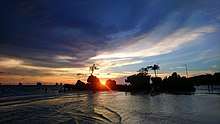
A landmark natural rock formation, Boracay's Rock, juts prominently directly in front of Willy's Beach Resort.
Statistics
According to the Department of Tourism of the Philippines, there was a recorded 1,725,483 visitors to Boracay in 2016. In 2015, there were 250 thousand fewer people who visited the island. Assuming the average length of stay of tourists to Boracay is three days, there were 14,182 tourists in Boracay daily in 2016, not counting the official population of 33,109.[64] According to Malay municipal records more than two million tourists visited the island in 2017.[54]
Sports
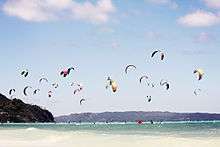
Boracay has been a competitive venue for the Asian Windsurfing Tour,[65] with the week-long Boracay International Funboard Cup competition usually held in January on Bulabog Beach. In 2010, the event dates are January 25 – 31.[66] CNNGo, a division of CNN focused on travel/lifestyle/entertainment, selected the Boracay International Funboard Competition on the weekend of January 22–24 as one of its 52 weekend recommendations for 2010.[67]
Dragon boat races are held annually on Boracay under the auspices of the Philippine Dragon Boat Federation, with teams coming from around the Philippines and from other Asian nations to compete. The races usually take place sometime in April or May. The 2012 Boracay Edition of the PDBF International Club Crew Challenge to was scheduled for April 26–28, in 2012.[68]
The Boracay Open Asian Beach Ultimate Tournament, an ultimate frisbee event, with players coming from around the Philippines and from other International nations, has been held annually since 2003, usually in March or April.[69]
Asian Games Centennial Festival
Boracay was scheduled to host a special multi-sport event in 2013. At its 31st General Assembly in Macau, the Olympic Council of Asia (OCA) decided to create the Asian Games Centennial Festival in celebration of the 100th anniversary of the Oriental Games (later Far Eastern Championship Games).[70] OCA awarded the hosting rights to the Philippines as it had been the host of the first Far Eastern Championship Games held in Manila 100 years earlier. The festival was to be held on Boracay in November 2013.[71] However, it had to be rescheduled and relocated because of Typhoon Haiyan, with the ceremony eventually taking place at the Sofitel Plaza in Manila on January 17, 2014. The 32nd OCA General Assembly was to be held in conjunction with the games.[72]
Culture
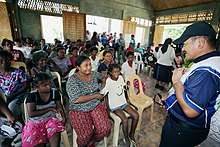
The first settlers of Boracay were a Negrito people called the Ati, and who spoke a Visayan language called Inati.[73] Later settlers brought other languages to the island, including Aklanon (as Boracay is part of Aklan province), Hiligaynon (Ilonggo), Kinaray-a, Capiznon, other Visayan languages, Filipino, and English.
The well-known Ati-Atihan Festival takes place each January in Kalibo on nearby Panay Island. A much smaller Ati-Atihan festival is celebrated on Boracay, usually in the second or third week of January.
Transportation
Boracay island is separated from Panay island by a narrow strait. The island is located opposite the barangay of Caticlan in the municipality of Malay, Aklan. Transportation across the strait is provided by boats operating from the Caticlan jetty port. Cagban Port serves as the primary sea transportation hub for passengers going into Boracay but the island lacks any formal seaport for cargo transport and waste disposal. Goods are delivered into Boracay through an informal port near the Cagban Port.[74]
Boracay is served by two airports in Aklan: the Kalibo International Airport and Godofredo P. Ramos Airport commonly referred to as the Caticlan airport.
The three main modes of transport are via motor-tricycles and electric-tricycles (e-trikes) along the main road, or by walking along the beaches. Pedicabs, known as sikads, are also available along the Beachfront Path. Other means of transportation include mountain bikes, quadbikes and motorbikes, all of which can be rented. It was reported in October 2018 that the island will see modern jeepneys, solar-powered shuttles, and hop-on hop-off buses serviced by Grab, and that the Department of Energy will donate 200 e-trikes to the Malay local government under a 1.73 billion peso project funded by the Asian Development Bank.[75]
The municipal government of Malay is currently encouraging motorcycle operators to transition to e-trikes in their coordinated efforts to promote environment-friendly public transportation. Diesel-motor tricycles are expected to be phased out by August 2018.[76]
See also
- Boracay Airport
- Tourism in the Philippines
Notes
References
- "Total Population by Province, City, Municipality and Barangay: as of May 1, 2010" (PDF). 2010 Census of Population and Housing. National Statistics Office. Archived from the original (PDF) on 2012-11-15. Retrieved 5 February 2013.
- "Boracay is top place for relaxation: poll". ABS-CBN News. Retrieved February 21, 2013.
- "Boracay beats Asian favourites to take crown as top destination". Good News Pilipinas. Archived from the original on 2013-10-30. Retrieved February 21, 2013.
- "Relaxation, nightlife both more fun in Boracay". Yahoo! Philippines. Retrieved February 21, 2013.
- "Boracay named 2012 worlds best island". ABS-CBN News. Retrieved February 21, 2013.
- "BORACAY named 2012 No.1 World's Best Island". Boracay Beach Live. Retrieved February 21, 2013.
- "The Best Islands in the World". Conde Nast Traveler. October 20, 2014.
- "TOP 10 DESTINATIONS TO WATCH IN 2016". Conde Nast Traveler. Retrieved November 18, 2016.
- "Philippines approves six-month closure of Boracay from April (VIDEO) - Malay Mail". www.themalaymailonline.com.
- "The new-Boracay opens with a whole new set of rules". thethaiger.com.
- "PNP: ALL SYSTEMS GO FOR BORACAY REOPENING". League Online News. Retrieved 2018-11-06.
- "Boracay bans tourists due to coronavirus fears". ABS-CBN News. March 18, 2020.
- Historically Digitized, Ro Isla it Buruanga.
- Clavecillas, Joyce (26 February 2018). "Paradise lost: Ati natives dread Boracay closure". ABS-CBN News. Retrieved 5 April 2018.
- Miguel de Loarca, Relacion de las Yslas Filipinas (Arevalo: June 1782) in BLAIR, Emma Helen & ROBERTSON, James Alexander, eds. (1903). The Philippine Islands, 1493–1803. Volume 05 of 55 (1582–1583). Historical introduction and additional notes by Edward Gaylord BOURNE. Cleveland, Ohio: Arthur H. Clark Company. ISBN 978-0554259598. OCLC 769945704. "Explorations by early navigators, descriptions of the islands and their peoples, their history and records of the catholic missions, as related in contemporaneous books and manuscripts, showing the political, economic, commercial and religious conditions of those islands from their earliest relations with European nations to the beginning of the nineteenth century.", p. 75.
- "Aklan Tour". Panublion Heritage Site. Archived from the original on 2011-09-27. Retrieved 2007-06-12.
- Our Province Aklan Historical Background (archived from [ the original] on 2014-05-29), The Provincial Government of Aklan Official Website supports assertion that Boracay is part of Aklan and creation date of Aklan province -->
- "REPUBLIC ACT NO. 1414 - AN ACT TO CREATE THE PROVINCE OF AKLAN". Chan Robles Law Library. April 25, 1956.
- Trousdale, William. "Governance in Context: Boracay Island, Philippines" (PDF). The Annals of Tourism Research: 7. Retrieved 6 June 2018.
- The Woman Behind the Greening of Boracay, The Sunday Times Magazine November 1987 by Nick I. Marte, Encyclopædia Britannica. (article text can be seen here)
- "aroundgrandmasrockingchair.com". Archived from the original on 2012-03-19. Retrieved 2012-01-31.
- Grele, Dominique; Lily Yousry-Jouve (2004). 100 Resorts in the Philippines: Places with a Heart. Asiatype, Inc. p. 225. ISBN 971-91719-7-9.
- As a filming location
- Filming locations for Too Late the Hero (1971), Internet Movie Database.
- de Guzman, Nicai (June 6, 2017). "These Vintage Photos of Philippine Beaches Are a Trip Back in Time". Spot. Retrieved June 5, 2018.
- Dela Paz, Chrisee (April 10, 2018). "LIST: Planned developments in Boracay". Rappler. Retrieved June 5, 2018.
- "Boracay Tops World's Best Beaches". The Philippine Star. Internet Archive. February 16, 1990.
- "WHAT WENT BEFORE: Boracay's environmental issues". Philippine Daily Inquirer. 13 February 2018. Retrieved 18 February 2018.
- Mayen Jaymalin (January 29, 2012). "Boracay named world's 2nd best beach". The Philippine Star. Archived from the original on February 8, 2013.
- Gita, Ruth Abbey (10 February 2018). "Duterte wants to shut down Boracay". Sun Star Manila. Retrieved 18 February 2018.
- Placid, Dharel (April 4, 2018). "Boracay closed for 6 months starting April 26, says Roque". ABS-CBN News. Retrieved April 5, 2018.
- "Duterte puts entire Boracay Island under land reform". The Philippine Inquirer. May 30, 2018.
- "Duterte: Original residents may sell awarded Boracay land to big businesses". ABS-CBN News. June 13, 2018.
- "Soldiers sent to secure Boracay". Philippine Star. April 24, 2018.
- Rey, Aika. "Boracay Island now open". Rappler.
- News, ABS-CBN. "Chinese businesses pop up in Boracay after island reopens". ABS-CBN News.
- News, ABS-CBN. "Local official confirms Chinese workers, businesses operating in Boracay". ABS-CBN News.
- News, ABS-CBN. "Wala tayong magagawa: DOLE says no control over Chinese businesses in Boracay". ABS-CBN News.
- History & Geography | Boracay Island | Boracay's Official Tourism SiteBoracay Island | Boracay's Official Tourism Site (archived from the original on 2013-12-13)
- Boracay to be developed as forest land – DENR official, gmanews.tv
- "G.R. No. 167707 and G.R. No. 173775, The Secretary of DENR vs. Mayor Jose Yap, Dr. Orlando Sacay vs. The Secretary of DENR, October 8, 2008". Archived from the original on October 11, 2008.
- SC affirms Proclamation 1064 on Boracay Archived October 10, 2008, at the Wayback Machine, inquirer.net
- Jay B. Rempillo, , Supreme Court of the Philippines.
- The Secretary of Tourism exercises administration and control mandate of the Philippine Tourism Authority over Boracay Island, Executive Order No. 706, s. 2008
- "Boracay establishments heed the call for voluntary redevelopment". Archived from the original on 2013-09-21.
- English, Fr. Leo James (2004). Tagalog-English Dictionary. Manila: Congregation of the Most Holy Redeemer. ISBN 971-08-4357-5. (19th printing)
- "Habagat Amihan Northeast Southwest: What Is Monsoon Weather?". Puerto Galera Yacht Club.
- "Philippines : Weather". Lonely Planet (travel guidebook). Retrieved 2014-06-25.
- "Malay Monthly Climate Averages". worldweatheronline.com. Retrieved July 21, 2020.
- "Monthly Typhoon Tracking Charts". Digital Typhoon. Retrieved 2008-12-13.
- Burgos, Nestor Jr. (2 September 2011). "Boracay's other attraction: Flying foxes". Philippine Daily Inquirer. Retrieved 18 February 2018.
- Ordinario, Cai (4 June 2015). "70% of Boracay coral reefs gone after 23 years–study". Business Mirror. Retrieved 18 February 2018.
- Gonzales, Yuji (9 June 2015). "Tourism activities damage 70 percent of Boracay corals—study". Philippine Daily Inquirer. Retrieved 18 February 2018.
- "Significant coral reef growth noted in Boracay". Manila Bulletin. 13 May 2017. Retrieved 18 February 2018.
- "DENR issues 51 notices of violation to erring Boracay establishments". CNN Philippines. 15 February 2018. Retrieved 18 February 2018.
- "Boracay Scuba Diving Emergency Action Plan". Boracay Scuba Diving Safety. June 12, 2017. Archived from the original on August 28, 2017. Retrieved June 18, 2017.
- "Alliance Global unit to spend P20-B for tourism estates". ABS-CBN News. June 30, 2011.
- "Discovery Shores Boracay, Discovery Primea win Condé Nast Johansens Awards for Excellence". Malaya. 19 January 2018. Retrieved 4 July 2018.
- News, ABS-CBN. "Five star Boracay resorts reassure staff, clients ahead of 6-month shutdown". ABS-CBN News. Retrieved 2018-07-08.
- "Forgotten island the ultimate escape". Stuff. 12 July 2010. Retrieved 4 July 2018.
- "Big Fat Hotel Wrap". Travel Weekly. 29 June 2017. Retrieved 4 July 2018.
- "Island in the sun: Where to live large on Boracay". CNN Travel. 5 January 2018. Retrieved 4 July 2018.
- Fairways & Bluewater Golf Resort, Graham Marsh Golf Design Archived 2009-08-17 at the Wayback Machine.
- "Boracay Island Guide for First Time Travelers". exploreiloilo.com. May 14, 2016.
- Quintos, Patrick (18 May 2017). "Time to limit number of tourists in Boracay: experts". ABS-CBN News. Retrieved 18 February 2018.
- The Asian Windsurfing Tour Archived June 1, 2010, at the Wayback Machine, Proteus Sports.
- "boracaywindsurfing.com - This website is for sale! - boracaywindsurfing Resources and Information". www.boracaywindsurfing.com.
- 52 Weekends: Go somewhere different every week Archived 2010-01-22 at the Wayback Machine, CNN GO;
^ Estan Cabigas, January 22-24: Boracay International Funboard Cup Archived January 21, 2010, at the Wayback Machine, CNN Go, 18 January 2010. - PDBF International Club Crew Challenge: Boracay Edition Archived 2012-05-06 at the Wayback Machine at Official Website Archived 2012-04-14 at the Wayback Machine of the Philippine Dragon Boat Federation.
- The Boracay Open Asian Beach Ultimate Tournament is organized by the Philippine Ultimate Association Archived 2014-09-30 at the Wayback Machine.
- "OCA General Assembly opens in Macau". OCA. Archived from the original on 2014-01-08. Retrieved 2012-11-09.
- "Philippines to host 2013 Centennial Asian Games". Inquirer Sports. Retrieved February 19, 2013.
- "OCA President describes Centennial Festival as symbol of solidarity". OCA. Archived from the original on 2014-02-05. Retrieved 2018-06-05.
- Mirla N. Cantalejo. Bridges to Communication: Language Power. Rex Bookstore, Inc. p. 52. ISBN 978-971-23-5150-1. Retrieved 2014-06-25.
- Yap, Tara (22 September 2018). "New port facility eyed in Boracay". Manila Bulletin. Retrieved 23 September 2018.
- Rey, Aika. "LOOK: E-trike, modern vehicles for the 'new' Boracay". Rappler.
- Miraflores, Pia. "Boracay shifts to e-tricycles by August". Rappler.
Further reading
- Roselle Tenefrancia (2010). Boracay Island: A case for reversing urban overdevelopment. Retrieved 2014-06-25.
- European Heritage Library; Sofia Lamberto (2008). The history and cultural exchange of the Spaniards in the Filipino island of Boracay.
- Janess Ann J. Ellao & Michael Cruz (2012). Boracay Island from the eyes of an Ati. Archived from the original on 2014-02-19. Retrieved 2014-06-25.
External links
| Wikimedia Commons has media related to Boracay. |
| Wikivoyage has a travel guide for Boracay. |

- Official Boracay Tourism website
